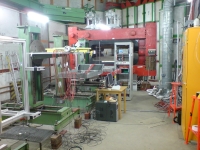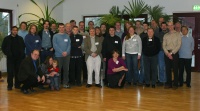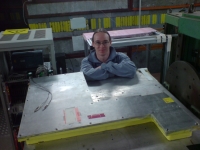 |
 |
|||||||||||||
|
|||||||||||||
|
|||||||||||||
|
Theorists and experimentalists aren't always of the same opinion. There is one thing on which opinions aren't polarised though, and that is polarisation. Polarisation is a special characteristic of a particle bunch – a sort of measure of the particles’ combined spin – that, when studied in the right sort of detector at the ILC, is supposed to give clues and answers on phenomena like the Higgs, supersymmetry or searches for new physics and extra dimensions. To study the collisions, and also to understand polarisation better, a few groups of a total of about 30 people around the world are designing and building polarimeters that measure the degree of polsarisation of the particles before and after collisions. They have just had their first 'collaboration' meeting at DESY in Zeuthen, near Berlin, Germany. The baseline plan for polarimetry at the ILC foresees four polarimeters, one each 'upstream' - before the particle bunches interact - and one each 'downstream', after electrons and positrons have collided and created an array of new particles, handing over a fraction of their polarisation in the process. Particle polarisation itself is currently planned to be 80% for electrons and 30% for positrons. The positron polarisation is directly related to the positron source, where the anti-electrons get polarised, which is why there was a one-day overlap between the positron source and the polarisation people. “Project Manager Marc Ross came to talk to us to get a thorough understanding of the polarimeters and their associated cost, and to tell us about the plans of the GDE,” says Jenny List, polarimetry expert from DESY Hamburg. “There has been talk of eliminating either the upstream or the downstream detector, and we pointed out that measuring the particle properties only really makes sense if you compare results from before and after the collisions. We had some very interesting discussions on this.” Measuring the spin of the bunches is important to the people who drive the machine as well as the people who run the detectors, because things like spin rotators have to be adjusted. Some experienced and thus key polarimeter experts are based at SLAC and weren't able to attend the meeting in person, so the organisers shifted the agenda back by a few hours, starting at 11 a.m. Berlin time and finishing at 8 p.m. to allow a few hours of phone conferencing with the US West Coast. A SLAC polarimeter detector from the former SLD experiment has recently found a new home in Hamburg, and a run in a test beam late last year, meant for a deeper understanding of the set-up, has shown first promising results. A beam delivery system's polarimeters are based on the effect that photons from a laser beam can knock single electrons out of a particle bunch. These 'Compton-scattered' electrons - about a thousand per bunch crossing - are sent through a magnetic chicane where they are deflected. The degree of deflection depends on their energy. Behind the chicane, the electrons are sent through gas-filled tubes with mirrors on the inside. Flying through the tubes, they emit a blue light - Cherenkov radiation - which is directed to the end of the tube by the inside mirror surface. A photo detector measures the amount of light that comes through. The upstream polarimeter would live some 1.8 kilometres away from the interaction point along the beam delivery system, the downstream one just a few tens of metres behind it. However, the downstream polarimeter (run by a team from SLAC) poses a much greater challenge: after the collisions the beams are very spread out and need to be re-focussed with strong magnets before a polarimeter can take hold of the particles. The next steps for the groups is another test beam with a reconfigured detector and seeping through the results. The performance of the ILC polarimeters has to be at least twice as good as that of any of their predecessors. -- Barbara Warmbein |
|||||||||||||
| © International Linear Collider |


